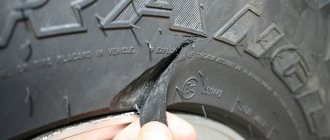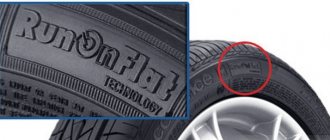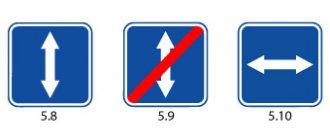One of the important points that influences the increase in the service life of tires for a car of any brand is compliance with recommendations for proper tire storage.
Every car enthusiast will have a question about how to store winter tires on rims in the summer. In the spring, with the onset of warmth, winter tires are changed to summer tires, and in the fall the car is “changed” for winter. Some car owners are faced with such an unpleasant situation when, having brought tires to a tire shop for replacement, they are told that such tires are no longer suitable for further use. A similar situation can arise even if you changed your tires only last season and the tread is not yet worn out, but the rubber is cracked or aged, making it unsafe to use on the road. This problem can arise if normal conditions for off-season tire storage have not been provided.
To avoid unpleasant situations and keep your tires in excellent operating condition longer, you should know how to properly store winter tires. Recommendations for storing tires in anticipation of the season for which they are intended will help you take into account room humidity, temperature conditions, and the position of the products so that they can last you as long as possible.
Tire storage according to GOST
Let's turn to the state document regulating the standards for packaging, transportation and storage of tires. It is called GOSTR 54266 - 2010. Basic recommendations for storing rubber specified in the document:
- In the storage room, the air temperature can range from -30 to +35 degrees. Moreover, if the rubber was stored in the cold, it must be kept in a warm room before installing it on the car.
- Do not leave tires closer than 1 m from sources of artificial heat.
- Tires should only be laid on a flat surface. This could be a floor, a rack or a pallet.
- If the width of the tire profile does not exceed 20 cm, place them horizontally on top of each other, not exceeding a height of 2 meters.
- Store larger tires with a profile width of 21 cm or more vertically.
- Change the position of the rubber every 3 months.
- If the tires are tubeless, position them so that their surface does not deform.
- If tires have already been used, thoroughly clean the surface before storing.
- Tires are allowed to be stored outside, but only for no more than a month. At the same time, they must be isolated from external influences, for example, folded under a canopy or covered with an awning.
By following the prescribed storage standards, you will ensure your wheels last a long time.
How to store tires without rims
It is recommended to store tires without rims vertically (positioning them close to each other is allowed). It is better to use a semicircular rather than ribbed surface as a support to avoid deformation.
It is not recommended to store tires without discs in a horizontal or suspended position, since the rubber can deform under its own weight.
But it is worth noting that even if the tires are positioned correctly, they must be rotated at least once a month. Mark where the rubber was directed and sign where it was installed so that the planned castling is correct.
These tips are rather advisory in nature, since if the tires do not sit for half a year as indicated, most likely, no noticeable consequences will occur. But if you are going to store rubber for much longer, then it is still worth considering a couple of important points :
- When storing tires in a stack without rims, the greatest pressure is placed on the sidewalls of the bottom tire, so it will be more difficult to side and inflate if the wheel width is slightly larger than the minimum recommended width.
- When keeping tires without rims suspended on a hook, try not to make it very thin. Otherwise, the rubber edges are deformed under the influence of mass, which can lead to installation difficulties. It is better to wrap the hook with something softer and thicker.
Tire storage depending on purpose
Tires should be stored at home based on their purpose.
Summer tires
It is clear that you will store summer tires in the winter, so in order to preserve their quality and performance characteristics:
- choose a dry place for storage;
- do not expose the rubber to direct sunlight;
- place the rubber away from radiators;
- Turn the tires over to the other side from time to time.
Winter tires
Store winter tires following these rules:
- thoroughly clean the surface of the tires before storing so that no dirt or dust remains in the tread pattern;
- choose a room that is dry, cool and dark;
- Ventilate the storage area regularly.
If you decide to store tires horizontally, reduce the pressure slightly, to about 1.5 atm.
To ensure that tires wear equally on all wheels, with the arrival of the new season, install the front tires in place of the rear wheels and vice versa.
Tires without rims
The main feature of tires without rims is their tendency to deform. It is unacceptable to store such tires in a horizontal or suspended position, as the rubber may deteriorate in the process. To preserve the quality of the rubber, install them in an upright position in a dry, ventilated area. Make sure that they are not exposed to sunlight and condensation does not collect on the surface.
Complete wheels
The storage area for wheel assemblies, just like for other tires, should be dry, dark and well ventilated. It is better to store tires on rims either horizontally or hang them on the wall. In the second option, the tires do not deform, since the entire load will be on the disks. If you decide to hang the wheels in a special bag or case, regularly ventilate the packaging to avoid condensation.
Factors that rubber tires are afraid of
If you want to know how to safely store winter tires on rims in the garage in the summer, it is worth considering the risk factors. All tires are made of rubber, so they are afraid of factors such as:
- Direct ultraviolet rays;
- High ambient temperature;
- Sudden temperature changes leading to the formation of condensation;
- Dust and dirt;
- High humidity.
Stored tires should not be exposed to dust or condensation. If the tires dry out, microcracks may form on them, which negatively affect the strength of the product, which can cause the tire to rupture while driving. In order to avoid getting into such a dangerous and unpleasant road situation and not becoming involved in an accident, you should know how to store winter tires with or without rims, and keep the tires in a safe place.
What affects the safety of tires
In any location chosen for storage, tires will be affected by various external factors. To prevent tires from deteriorating while they are not in use, such factors must meet certain standards.
Moisture
Rubber may lose its quality characteristics if stored in a room with too much humidity, so choose only a dry, well-ventilated place for storage.
Do not place tires in plastic bags, as condensation may form inside over time, which will negatively affect the rubber and may cause wheel corrosion.
sunlight
To prevent cracks from appearing on the surface of the tires, insulate them from sunlight. Direct rays of the sun are detrimental to rubber, as they greatly dry out the coating. Subsequently, due to such influence, the tires will wear out faster and may even burst if the wheel gets into a hole.
Temperature
Rubber does not tolerate the effects of low temperatures well, but at the same time does not tolerate overheating. The place for tires should not be cold, but not too heated. The ideal option is a room with an air temperature from 0 to +25 degrees.
Chemicals and deformation
If you choose a garage to store tires, make sure that gasoline, solvents and other harmful auto cosmetics do not get on the surface. The impact of such substances on tires will have a detrimental effect on its performance characteristics.
Pay special attention to the position of the tires during storage, as they may become deformed. Select the position in accordance with the purpose and type of tires.
Shelf life
Most often, on the packaging of new tires, the manufacturer indicates a shelf life of a maximum of 6 years. During this period, the quality of the rubber will be maintained, the surface will not dry out or crack, but only if the tires are in proper conditions. Keep this in mind if you are purchasing tires for the future.
Please note that tires installed on a car retain their original quality longer. This happens due to the fact that during operation the rubber is affected by the chemical softeners contained in the composition.
Where to store wheels and why
First, you should decide on a place to store your tires. And then, when dislocation emerges, we can talk about storage methods and conditions. A great and easiest method for getting rid of tires is to stack them under the garage and cover them with roofing felt. This way they will definitely never require storage space again.
In order for tires to be useful for more than one season, it is necessary to follow the simplest rules for their protection. If you do not adhere to these rules, then depending on the season you may find that the tires are virtually unusable. Cracks will appear not only on the surface of the tire, but internal cracks may also occur, which is even more dangerous, since visually they will look normal, but after a hundred or two kilometers a hernia may grow on the tire, and in the worst case, it will rupture while driving. Therefore, you need to store tires not only to increase their service life, but also for your own safety.
We recommend: How to properly bleed the brakes on a VAZ-2114?
Selection of storage space
When choosing where to place your wheels while they are not in use, consider the basic requirements for storage space.
In an apartment or house
If you live in an apartment, you can leave your tires:
- In the pantry. The room will be an ideal place to store tires if it is not exposed to steam from the bathroom or too warm air from the kitchen. Make sure there are no chemicals near the rubber.
- In the cellar. The room is perfect for storing tires if it is warm and dry enough.
Please note that storing tires on a staircase or vestibule is against fire safety regulations, and tires may disturb neighbors.
On the balcony
You can store rubber on the balcony only if it is heated and glazed. If you place tires on an open balcony, it will be the same as leaving them on the street, and no storage standard will be met.
If the balcony is suitable for storing rubber, follow these recommendations:
- place the rubber in special covers to protect them from possible exposure to sunlight;
- prepare storage space in advance;
- do not dump tires on a pile or in a stack;
- the best option for placing rubber on the balcony is a vertical position;
- Make sure that there are no other objects on the vertical wheels that could deform the product;
- Rotate your tires periodically to prevent damage.
If you correctly fulfill the described conditions, the tires will lie on the balcony for a long time without losing their technical qualities.
In the garage
If you decide to leave your tires in the garage, pay attention to the following nuances:
- in a garage made of metal sheets, storage is permissible only in winter, since in summer the metal gets very hot;
- a wooden room is better, but it is too fire hazardous;
- During storage, make sure that various chemicals, such as gasoline or solvent, do not come into contact with the surface of the rubber.
The ideal place for tires would be a brick garage. Normal temperature and air humidity will be maintained here. To prevent wheels from taking up much space, equip them with a special shelf or rack.
Car storage
Many car enthusiasts may not use a car with wheels for a long time. To prevent the rubber from deteriorating during this period:
- Place the car on special stands and cover the wheels with covers;
- change the position of the car from time to time so that the pressure on the tires is even;
- unload the interior as much as possible to reduce pressure on the wheels.
How to store tires on rims
The rubber on the disks is contained in a lying position (to save space, the wheels can be folded on top of each other) or in a suspended state. The best option for storing tires and rims is when the wheels hang on the wall, each on its own hook. You can also store rubber stacked on top of each other, but to avoid deformation, they will need to be turned over every month. In any of these cases, it is necessary to inflate the wheels, bringing the pressure to normal.
Unlike tires without discs, the wheel assembly should not be in a horizontal position, standing on the tread, since its mass is quite large and significantly deforms the tire.
To clear your conscience, you can use another way to influence seasonal preservation - treat it with a special tire preservative, or with plain water half diluted with glycerin. There is an opinion that this helps rubber protect itself from many adverse effects. The outside of the tires is wiped with this solution immediately before preservation.
What is a tire hotel
If you don't have room for tires, you can use a relatively new service - take your wheels to a tire hotel. Such premises are most often equipped by car service centers. Here, all conditions for high-quality storage of rubber are met in the best possible way. The tire hotel has specially trained specialists who prepare the rubber before laying it and ensure that the conditions are met.
Is it necessary to take the wheels to a service center for storage?
It all depends on your financial capabilities and desire to maintain the performance characteristics of the rubber. In fact, the services of a tire hotel are not very expensive, approximately 1500-2500 rubles. per season. Agree, this is several times cheaper than buying new tires if they get damaged during improper storage.
What to look for at a tire hotel
Before sending wheels to a hotel for storage, it is better to independently check whether the storage room is suitable, since some companies neglect the standards prescribed by GOST.
Before concluding an agreement with the service, inspect the premises. It shouldn't be here:
- radiators and other heaters;
- dust and debris;
- windows;
- high humidity;
- mold.
If you notice that the service center neglects suitable conditions for storing rubber and does not provide a guarantee, refuse the company’s services.
Do tires need to be changed?
Indeed, just a few decades ago, drivers did not bother with seasonal tire replacements, but operated their cars on all-season wheels. Today, most of us use specialized summer and winter tires, which can significantly increase the safety of car operation, especially in the winter on snowy and slippery roads.
High-quality winter tires not only have an appropriate tread pattern that provides traction on slippery roads, but are also made of a special compound that retains its properties even at low temperatures.
It is only necessary to ensure appropriate proper storage of winter and summer tires, which will avoid the occurrence of static deformation, cracking and damage to the tread.
Adviсe
After using the wheels, check the tires for defects and wear. Before storing, follow these procedures:
- if the front and rear tires are worn differently, swap them;
- measure the tread depth; if it is minimal, the wheels will soon become unusable;
- study the expiration date of the rubber, and if it exceeds 6–7 years, hurry to buy new tires, as the old one begins to lose its physical properties.
Flag tires
In order not to forget later on which axle and which side the tires were on, mark them before storage. Place the symbol “PP” on the front right wheel, “PL” on the front left wheel, “ZP” on the rear right wheel, and “ZL” on the left wheel. In the future, you will be able to easily find the location of the tires or, if necessary, swap them.
How to treat tires before storage
To ensure that the rubber retains its previous qualities, do the following before storing:
- thoroughly wash the surface from dust, dirt and small stones;
- Pay utmost attention to cleaning the surface from residual oil and petroleum products;
- After washing the rubber, be sure to dry it; leaving the surface wet is strictly not recommended;
- treat the rubber with a special compound, for example, a rubber preservative.
Properly treated wheels will last the required time without losing their physical properties.
How to fold
Tires without rims may only be stored in an upright position. A semicircular surface of suitable size would be ideal. If you stack your tires on a shelf or floor, rotate them periodically.
Is it possible to pack wheels in polyethylene?
Sometimes, for storage, tires are packed in dark plastic bags, which well protect the material from exposure to precipitation and light. However, condensation may accumulate inside the plastic bag, which is detrimental to the rubber. To prevent excessive moisture inside, do not close the bags completely and air the wheels regularly. As an alternative, you can use special “breathable” covers.
Preparing the tires
The first step is to do standard processing of the tire in order to preserve it, so to speak, in its original form:
- Washing. Before sending tires for further storage, thoroughly clean the tires of all kinds of stones, dust, oil, dirt and other third-party objects that may have gotten stuck there during the period of operation.
- Drying. It is extremely important to keep rubber dry, since increased moisture has a destructive effect on it.
- Conservation. There are special protective products on sale that help prevent premature destruction. However, it is extremely important to use the instructions here, since excessive amounts of chemicals can only cause harm.
It's important to know: a little trick will help you avoid many problems associated with installing tires when the time comes. In order to know exactly which tire needs to be installed on a particular wheel, simply mark them in a way convenient for you.
For example, with a special sticker or permanent marker. Also remember that tires should only be stored in an upright position, as improper placement can affect the tire's grip on the rim.
We recommend: Grooving brake discs without removing: how to do it yourself
Common storage mistakes
The main mistake when storing wheels is the wrong location. Be sure to take into account all the factors described above that affect the safety of your tires.
Another common mistake is incorrect placement of tires during storage. Please note that assembled wheels can be stored hanging or in a stack; vertical placement is strictly not allowed. Tires without rims, on the contrary, are only allowed to be stored while standing. In this case, the rubber is deformed if:
- keep tires on corners, cables or channels, so the tires will have a small number of support points;
- hang the tires on hooks, they will stretch out;
- stack, the lower wheel will flatten.
If stored incorrectly, it will be difficult to put the tires on the axle. However, it is not safe to use such tires.
To preserve the pristine quality of rubber, ensure suitable storage conditions. Choose the correct tire position depending on whether they are on rims or not. Make sure that the storage location is not exposed to temperature changes, precipitation or exposure to direct sunlight.
What are the consequences of improper storage?
Before replacing tires, inspect them carefully. Signs of improper storage are as follows:
- Cracks and hernias. If the tire was stored in direct sunlight or in abnormal temperature conditions, this will be noticeable.
- Loss of elasticity. If the tire is “oak”, it means that it was stored with improper temperature conditions.
- Deformation of the cord and sidewall.
The consequences of improperly storing tires can be tragic:
- The tire may burst while driving due to cracks and hernias.
- The car may lose its smooth ride due to inelastic, “hardened” tires.
- The wheel may come loose while driving.
Proper tire storage is an important factor in ensuring vehicle comfort and long tire life. If you follow simple rules, your car wheels will serve faithfully for many years.
Myth No. 4. If there are no “special covers” - use plastic bags
This advice can be found exclusively on the Russian-language Internet. What to do if you don’t have money or feel sorry for store-bought covers for storing tires? Right. Find a decent cheap analogue. And such an analogue is garbage plastic bags. Legend says that it is ideal if they are black...
At first, gullible and overly timid motorists preserved their tires in such bags, sealing the contents completely hermetically. So that not a single microbe can penetrate and corrode the rubber. Then someone packed the tires on rims in this way, and by spring the latter were covered with rust. Strict advice has been circulating on the Internet, or rather an important clarification to the previous one - the tire must be placed in a bag so that there is access for air. Because condensation forms in a closed space, and, naturally, the metal corrodes. Ready. Another myth has matured. You can evaluate its adequacy yourself. Only soberly.
Yes. Theoretically, such packaging will protect the rubber from direct ultraviolet radiation. And this thing really shortens its service life. But again. This is justified only when the storage space is an open area that receives daily and hourly sunlight. There is no such harmful influence indoors, and therefore protecting yourself from it means showing the first signs of paranoia.
As for GOST, packaging in general has already been discussed. But there really are a couple of lines about ultraviolet radiation. But they are dedicated to industrial warehouses with huge windows through which the sun shines on endless stacks of tires during daylight hours. If your garage has the same picture, covers or garbage bags won’t hurt.
Myth No. 2. It is advisable to treat rubber with a “special agent” before storage.
Such products are sold today in a wide range. What kind of miraculous properties are not attributed to them. They almost have a “rejuvenating effect”, due to which the tread depth increases during storage. Unfortunately, this is nothing more than marketing ploys that are written on the packaging in order to sell ordinary silicone lubricant at the price of 20-year-old cognac.
By the way, about silicone grease . It really penetrates into the pores of rubber (although not as deeply as they say), displaces and repels moisture, and also softens. Maintains elasticity. Protects against mold and mildew. This is all verified truth. But there is one “but”. Just like special aerosols , and cheap silicone oil, all this works after treating the tire for just a couple of days. And under certain conditions - no more than a few hours. Whether fussing with this processing is worth it is a purely individual matter. However, if you look at things soberly, then against the backdrop of 3-4 months of storage, such an effect does not turn out to be particularly useful.
And again let's return to our GOST. There is not a word about any processing there. Especially about silicone oils and aerosols based on them. And this despite the fact that GOST is relatively “fresh”, 2012. That is, at the time of its composition they already knew about silicone.
Preparing winter tires
Before storing winter wheels, they must be properly prepared. And the long service life of the wheels and the absence of any problems during tire operation will largely depend on the correctness of such preparation.
If you plan to disassemble the tires, then on the sidewall you need to write in chalk which wheel it is, whether it was on the left or right, located on the front and rear axles. It is best to make such a designation with a marker or special paint, but the chalk may be erased during storage and certain difficulties will arise with the subsequent installation of tires on the car.
Winter tires should be washed, removing all existing oil stains and other contaminants. All pebbles are removed from the tread, the presence of which can lead to problems with the geometry of the contact patch. Stones impair traction, the wheels themselves will wear out faster, and the tires will soon need to be replaced.
Ideally, when preparing winter and summer tires for storage, the car owner needs to dry the wheels and treat them with a special compound that is intended for preserving wheels. Such auto chemicals can be easily purchased at most automobile stores, they are affordable, and the use of such sprays will significantly extend the service life of tires.
Proper storage of winter and summer tires will be the key to trouble-free operation of car tires. Such wheels will retain all their performance characteristics and will serve the car owner for as long as possible, which invariably affects the safety of driving the vehicle and the driver’s costs of operating the vehicle. It is only necessary to store the wheels correctly, protect them from dampness, ultraviolet radiation from sunlight and ensure the correct humidity and temperature conditions. This will allow you to store your car tires without any difficulty.











